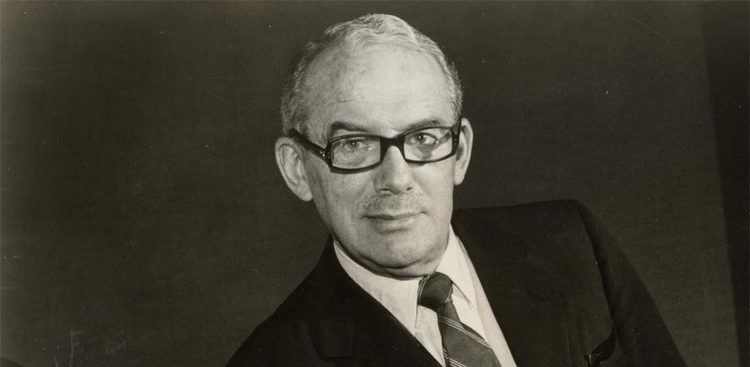Name David Brown | ||
 | ||
Occupation Industrialist, entrepreneur Known for David Brown Ltd.Aston Martin | ||
David brown interviews danish serial entrepreneur martin thorborg
Sir David Brown (10 May 1904 – 3 September 1993) was an English industrialist, managing director of his grandfather's gear and machine tool business David Brown Limited and more recently David Brown Tractors, and one time owner of shipbuilders Vosper Thorneycroft and sportscar manufacturer Aston Martin.
Contents
- David brown interviews danish serial entrepreneur martin thorborg
- Early life and David Brown Sons
- Tractors
- Aston Martin
- Personal life
- References
Early life and David Brown & Sons
Brown was born in Park Cottage — pulled down in the Second World War to make way for a new factory — on their 17 acre Park Works site in Huddersfield, Yorkshire. After attending King James's Grammar School, Almondbury and Rossall School he started work aged 17 as if just another apprentice in his family's business, David Brown & Sons (Huddersfield), cycling 6 miles to work by 7 a.m. Following a grounding in various parts of their works he progressed to foreman, assistant works manager, then director and on his uncle Percy's death in 1931 was appointed managing director.
His mother was a keen driver and as a small child he had ridden beside Frederick Tasker Burgess on test runs of David Brown & Sons new Valveless car but he did not learn to drive until aged 11. His father had no interest in cars and did not drive but he offered to buy him a motorcycle for transport to work. At weekends he competed on it to such effect he was asked by Douglas motorcycles to be a reserve for their Isle of Man Tourist Trophy team but his parents forbade it.
He designed and built his own 1.5 litre straight eight engine and a car for it he called a Davbro. David Brown & Sons' special gear-grinding skills brought him early contacts with Bertelli of Aston Martin for gears and Amherst Villiers for his superchargers. With the consent of Villiers Brown modified a Vauxhall which then won its class at Shelsley Walsh for three consecutive years. It was said to be capable of more than 140 mph on the sand.
Sent to the United States, Africa and Europe in 1928 to study business methods and factory conditions he returned and started a bronze and steel foundry in Penistone where unemployments was severe. The new foundry used a new technique of steel casting and was a rapid success. As well as meeting his group's own needs the foundry made steel and bronze castings as follows: aircraft air frame and aero engine components; heavy components of electricity and nuclear-powered plants, oilfields and oil refineries. All this together with precision castings for "innumerable" industries. Brown wanted a product of his own.
Tractors
In 1934 David Brown & Sons built a new factory on a site at Meltham, on the south side of Huddersfield. Brown, who also owned a farm, started the Ferguson-Brown Company building tractors with Harry Ferguson there in 1936, but they disagreed over design details, which led David Brown to design his own version. During the Second World War his new heavier tractor, called the David Brown VAK1, was produced, with over 7,700 units eventually sold, making Brown into a wealthy man. Harry Ferguson went to America and did a deal with Henry Ford to incorporate his system in the Ford N-Series tractor, before setting up Ferguson Tractors. In 1972, the David Brown tractor interests were sold to Tenneco International and were rebadged as Case.
Aston Martin
In 1947, Brown saw a classified advertisement in The Times, offering for sale a "High Class Motor Business". Brown acquired Aston Martin for £20,500 and, in the following year, Lagonda for £52,500, followed by the coachbuilder Tickford in 1955. He subsequently concentrated all the Aston Martin manufacturing at the Tickford premises in Newport Pagnell.
The legendary 'DB' series of Aston Martin cars, including the Atom, the DB1 (2 Litre Sports), the DB2, the DB3, the DB4, the DB5, the DB6, DBS were named after Brown using his initials. Ironically, while at the helm of the Aston Martin company, he actually used a rival product, a Jaguar XJ Series I, as personal transport. Aston Martin was sold off in the 1970s when the company was in financial difficulties.
Personal life
In his personal life Brown owned racehorses, played polo at Ham Polo Club, raced cars and motorcycles, and was a qualified pilot. He was knighted in 1968.
He married Daisy Muriel Firth in 1926 and they had two children, David and Angela, both of whom entered the family business. Angela married George Abecassis the racing driver. He married Marjorie Deans (his secretary) in 1955 and Paula Benton Stone (his personal assistant) in 1980.
Sir David Brown died in September 1993 in Monte Carlo. Eight years later David Brown Limited was acquired by Textron
